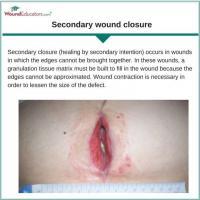Types of Wound Closure

There are three types of wound closure: primary, secondary and delayed primary closure. Let’s look at each of them in a little more detail.
Primary wound closure
Primary closure (sometimes referred to as healing by primary intention) is the fastest type of wound closure. A good example of primary closure is a paper cut. You slice your finger open, leaving a small wound that you cover with a Band-Aid. The edges of the wound are even and well-approximated, therefore there is a very short distance over which keratinocytes and new blood vessels must travel. Wound contraction is very fast across linear wounds, thus the process of proliferation and reepithealialization begins very quickly. When there is good blood supply and low tension across the wound, these wounds heal very quickly. Surgical incisions are a good example of wounds which heal by primary intention.
Secondary wound closure
Secondary closure (healing by secondary intention) occurs in wounds in which the edges cannot be brought together. In these wounds, a granulation tissue matrix must be built to fill in the wound because the edges cannot be approximated. Wound contraction is necessary in order to lessen the size of the defect. Obviously, in this type of wound closure epithelialization is more complex and will take longer. There is also greater scar formation in this type of wound closure. How long do wounds that heal by secondary closure take to achieve complete healing? This will depend on the rate of contraction of the wound and the depth of tissue loss. The larger and deeper the wound, the longer it will take to heal. Certain areas may heal better by secondary intention, such as the forehead, temple and the nasal alar creases.
Delayed primary wound closure
Sometimes called healing by tertiary intention, delayed primary closure is a combination of primary and secondary closure. This type of closure is often preferred when a wound is heavily contaminated to reduce the risk of the wound becoming infected. The wound is cleansed and is watched closely for several days. When the wound appears to be clean and on its way to healing, it is closed surgically. When there is tissue loss, such as might occur in an avulsion injury, wound closure is often delayed to control wound debris and necrotic tissue. Certain types of injuries almost always become infected (i.e. dog bite injuries); these types of injuries are frequently left open and are closed only when infection is controlled.
If you are interested in learning more about wound care management, consider becoming a certified wound care consultant. Wound care certification can refresh your knowledge, cement your skills and demonstrate your superior knowledge in this specialized area. For further information about wound care certification, visit www.woundeducators.com.
Sources
Doud Galli, S & Constantinides, M. Wound Closure Technique. Medscape. Updated April 2013.
Myers, Betsy. (2008). Wound Management Principles and Practice. Pearson Prentice Hall. Upper Saddle River, New Jersey pg. 17-18.


I would like to certificate, where I ‘ll address to take the exam certification
Please view our wound care certification courses for detailed information on how you can apply for the course and exam. You can also contact us for detailed information.
Hello:
I would like to sign up for your online certification.
Our outcomes are 90+ % healed and/or improved and re-hospitalizations have been cut by 50%.
Best, Monty
Hi Monty, I recommend that you look at our wound care certification courses and choose the course that best meets your educational background. If you have any questions please contact us.
Can the course study be left open for study and review past 6 months?
Hi Daphne, The course can easily be completed in 6 months, however we do offer extensions at $100/30 days should you require more time.
For more information and to register, view our wound care certification courses